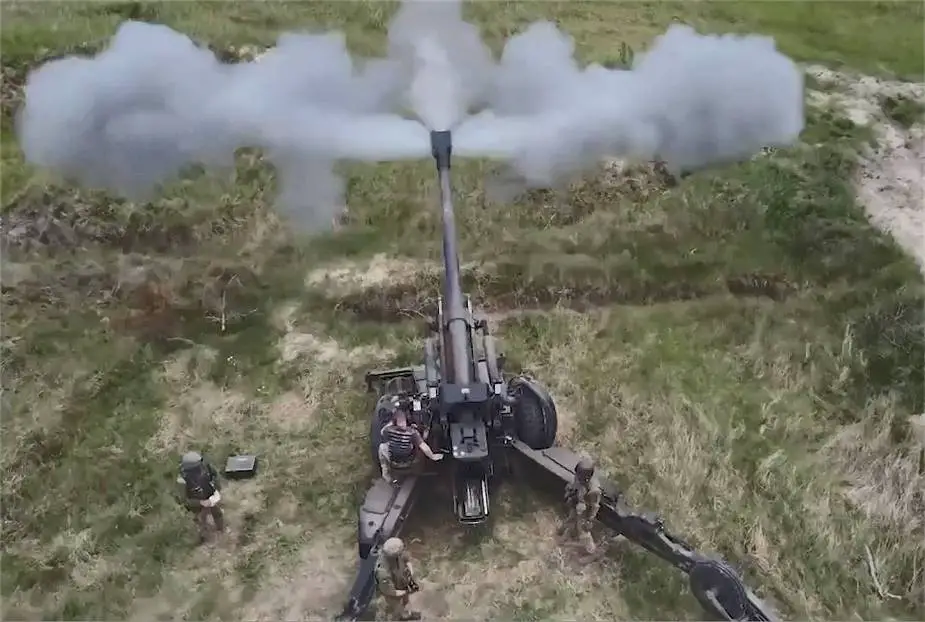According to a video published by the Ukrainian Ministry of Defense, the FH70 155mm towed howitzers donated by Italy are now deployed for combat operations and are used by Ukrainian army soldiers to fight Russian troops. It is impressive to see how quickly Ukrainian soldiers learn the use of all their new artillery systems that are totally different from their Russian-designed military equipment. In this article, the Army Recognition editorial team explains the combat capabilities of the FH70.
Follow Army Recognition on Google News at this link

Ukrainian soldiers use the FH70 155mm towed howitzers donated by Italy to fight Russian troops. (Picture source Screen Shot Video Ukrainian MoD)
On May 15, 2022, the Army Recognition editorial team reported that Italy would supply FH70 155mm towed howitzers coming from its own military inventory.
The FH70 is a 155mm towed howitzer that was jointly developed and designed by the United Kingdom and Germany. A total of 19 prototypes of the FH-70 were completed and after extensive trials, the weapon was accepted for service in 1976, with the first production weapons being completed in 1978. Germany ordered 216, Italy 164, and the UK 71 FH-70s.
The FH70 is operated by a crew of eight and can be deployed to conduct firing operations in less than 2 minutes. It has a traverse of 56° left and right and an elevation from -5° to +70°. The howitzer has a weight from 7,800 to 9,600 kg with a barrel length of 6 m. The FH-70 can be towed by a wide range of military trucks at a maximum road speed of 100 km/h.
The FH70 comprises the ordnance, cradle with an integrated recoil system, and the loading mechanism. The ordnance consists of a mono-bloc barrel fitted with a double-baffle muzzle brake, a breech mechanism incorporating a semi-automatic vertically sliding block and an automatic tube loader with a capacity of nine tubes, spent tube ejection, and an emergency firing mechanism.
The cradle of the FH70 carries a 155 mm/39 caliber cannon and includes a semi-automatic loading system. The gun can fire all NATO standard 155mm shells. A special range of 155mm shells was developed for the FH-70, including a powerful low drag HE-Frag shell. The gun has a maximum firing range of 24.7 km using NATO standard ammunition and 30 km with extended range shells. The burst rate of fire is 3 shells in 15 seconds. The sustained rate of fire is 3 to 6 rpm. It can be also dor direct fire against land targets.
The sighting system of the FH70 is mounted on the left of the saddle and consists of a support bracket, a dial sight carrier incorporating a quadrant elevation scale and leveling bubbles, a periscopic dial sight, and a direct fire telescope. A direct fire night sight can also be fitted. All scales, graticules, and bubbles are self-illuminating. The sight carrier incorporates transducers for azimuth and elevation.
One of the main features of the FH70 is the integration of an APU (Auxiliary Power Unit) which is housed in a space frame attached to the forward part of the carriage and consists of a commercial Volkswagen 1,800 cc engine with a gearbox, differential, batteries and a hydraulic pump. In the APU mode, the FH-70 can attain speeds up to 16 km/h and is capable of negotiating slopes up to 34 percent. When being towed, it can ford to a depth of 1.5 m and when using the APU to 0.75 m.
The functions of the APU include driving the main wheels for moving the howitzer, providing hydraulic power for steering and raising and lowering both the main and trail wheels. This facility allows for rapid unhooking, lowering the howitzer onto its soleplate, easy opening and lowering of the trails when going into action, as well as extracting the spades from the ground, lifting the equipment, rapid closing of the trails and limbering up. In an emergency, or when the APU has been removed, power is provided by a hand pump.















